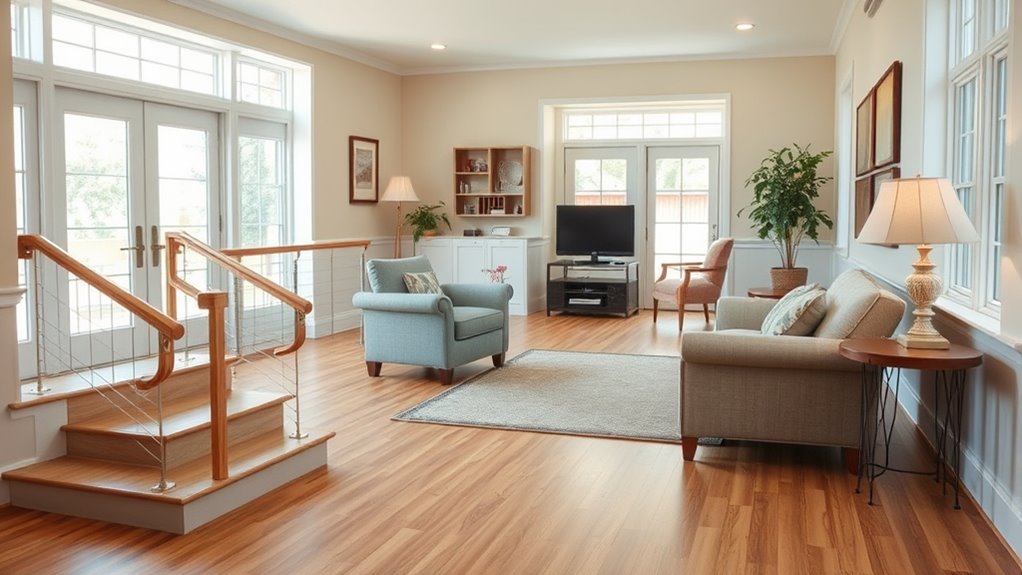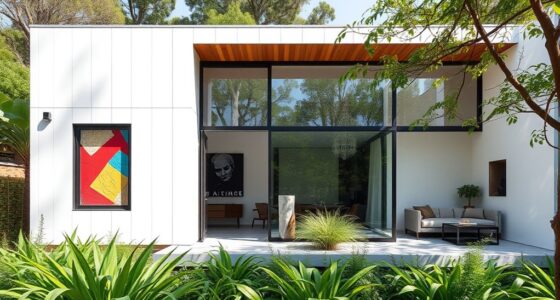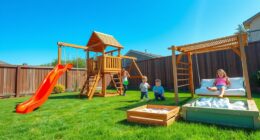To make your home age-friendly, focus on safety improvements like secure rugs, good lighting, and grab bars in bathrooms. Guarantee accessibility by widening doorways, using lever handles, and designing open, clutter-free spaces. Incorporate future-proofing features, such as walk-in showers and adaptable layouts, that can change with your needs. Thoughtful lighting and secure pathways enhance visibility and safety. If you want to learn how to create a home that combines safety, style, and adaptability, keep exploring the essentials.
Key Takeaways
- Incorporate safety features like grab bars, slip-resistant flooring, and clutter-free pathways to prevent falls and injuries.
- Design with universal accessibility, including widened doorways, low thresholds, and accessible switches and outlets.
- Future-proof the home by planning adaptable layouts and features that accommodate changing mobility and health needs.
- Ensure comprehensive lighting with ambient, task, and motion-activated lights for visibility and hazard prevention.
- Create a comfortable, stylish environment that promotes independence, security, and ease of movement for all users.

Designing an age-friendly home means creating a space that promotes safety, comfort, and independence as you age. You want your environment to adapt to your evolving needs, making daily activities easier and reducing the risk of accidents. A key aspect of this is prioritizing home safety by eliminating hazards that could cause falls or injuries. Simple changes like securing loose rugs, installing grab bars in the bathroom, and ensuring good lighting can dramatically improve safety. It’s about creating a space where you feel secure, with every detail thoughtfully planned to prevent accidents before they happen. Incorporating projector technology can even enhance entertainment options, making your home more enjoyable and accommodating for all ages.
Creating a safe, comfortable, and accessible home helps you stay independent and secure as you age.
Universal accessibility plays a vital role in this design approach. It means making your home usable by people of all ages and abilities, including those with mobility challenges. To achieve this, you might consider widening doorways to accommodate wheelchairs or walkers and installing low-threshold entryways to prevent tripping. Lever-style door handles are easier to operate than traditional knobs, especially for those with arthritis or limited hand strength. Also, placing switches and outlets at accessible heights ensures you can control lighting and appliances comfortably without straining or reaching. These modifications aren’t just for now—they future-proof your home, so it remains functional as your mobility or health changes over time.
Creating universal accessibility isn’t about making your home look clinical; it’s about blending practicality with aesthetic appeal. For example, choosing flooring materials that are slip-resistant yet stylish helps prevent falls without compromising design. Installing a walk-in shower instead of a bathtub makes bathing safer and easier to access. When planning your home layout, consider open floor plans that reduce clutter and provide ample space to move freely. This not only enhances safety but also makes your home more welcoming and easier for others to assist if needed.
Lighting is another critical element. Well-lit spaces help you see potential hazards clearly, reducing the chance of trips or falls. Use a combination of ambient, task, and accent lighting to ensure every corner is illuminated. Motion sensors can automatically turn on lights as you enter a room, adding convenience and safety. Additionally, keeping pathways free of clutter and securing cords along walls minimizes tripping hazards, making your home safer for everyone.
Ultimately, designing an age-friendly home with a focus on home safety and universal accessibility allows you to maintain your independence and enjoy your space for years to come. It’s about thoughtful planning—balancing safety, functionality, and style—so that your home adapts seamlessly to your needs as you age, giving you peace of mind and confidence every day.
Frequently Asked Questions
How Can I Modify My Existing Home to Be More Age-Friendly?
You can modify your existing home by incorporating universal design principles and adaptive features. Install grab bars in bathrooms, add ramps at entryways, and replace thresholds with level flooring. Widen doorways for easier wheelchair access, and use lever handles instead of knobs. These updates make your home safer, more accessible, and comfortable as you age, ensuring you can stay independent and enjoy your space longer.
What Are Cost-Effective Solutions for Aging-In-Place Modifications?
You can make your home more age-friendly with budget-friendly upgrades like installing simple home automation features, such as smart lighting or voice-activated controls, to improve safety and convenience. Focus on cost-effective solutions like adding grab bars, slip-resistant mats, and improved lighting. These modifications are affordable, easy to implement, and markedly enhance safety, helping you stay independent longer while keeping expenses manageable.
How Do I Choose the Best Materials for Safety and Durability?
Choosing the best materials for safety and durability is essential, so don’t settle for anything less than the toughest! Opt for non-slip flooring that keeps you steady on your feet and slip-resistant fixtures that prevent accidents. Look for high-quality, abrasion-resistant surfaces, and durable finishes that withstand daily wear and tear. By prioritizing these materials, you create a safer, more reliable home that lasts a lifetime.
Are There Specific Design Features Recommended for Mobility Impairments?
You should include grab bars in bathrooms and near the shower or toilet to prevent falls. Install stairlifts on staircases to assist with mobility between floors. Widen doorways to accommodate mobility aids like wheelchairs or walkers. Use non-slip flooring throughout the home, especially in wet areas. Incorporate smooth, step-free progressions and guarantee lighting is adequate to improve visibility. These features make your home safer and more accessible for mobility impairments.
How Can Technology Enhance Age-Friendly Home Environments?
Imagine a home that responds to your every need—smart home technology and assistive devices working seamlessly behind the scenes. You can control lighting, temperature, and security with simple voice commands or remote apps, making daily routines easier. Sensors detect falls, alerting help instantly. Technology transforms your space into a safer, more comfortable environment, giving you independence and peace of mind, all while you enjoy the comfort of a truly age-friendly home.
Conclusion
By incorporating age-friendly design principles, you create a safer, more comfortable home for yourself or loved ones. Did you know that falls are the leading cause of injury among older adults, yet simple modifications like grab bars and good lighting can reduce this risk markedly? Embracing these principles not only enhances safety but also boosts independence and peace of mind. Start planning today to make your home a welcoming space for all stages of life.









